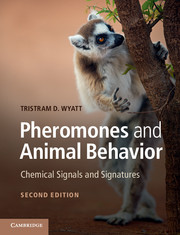Crossref Citations
This Book has been
cited by the following publications. This list is generated based on data provided by Crossref.
Harris, W. Edwin
and
Moore, Patricia J.
2005.
Female Mate Preference and Sexual Conflict: Females Prefer Males That Have Had Fewer Consorts.
The American Naturalist,
Vol. 165,
Issue. S5,
p.
S64.
Nehring, Volker
Wyatt, Tristram D.
and
d’Ettorre, Patrizia
2013.
Animal Communication and Noise.
Vol. 2,
Issue. ,
p.
373.
Puechmaille, Sébastien J.
Borissov, Ivailo M.
Zsebok, Sándor
Allegrini, Benjamin
Hizem, Mohammed
Kuenzel, Sven
Schuchmann, Maike
Teeling, Emma C.
Siemers, Björn M.
and
Russo, Danilo
2014.
Female Mate Choice Can Drive the Evolution of High Frequency Echolocation in Bats: A Case Study with Rhinolophus mehelyi.
PLoS ONE,
Vol. 9,
Issue. 7,
p.
e103452.
Cardé, Ring T.
2014.
Defining Attraction and Aggregation Pheromones: Teleological Versus Functional Perspectives.
Journal of Chemical Ecology,
Vol. 40,
Issue. 6,
p.
519.
Pérez-Gómez, Anabel
Stein, Benjamin
Leinders-Zufall, Trese
and
Chamero, Pablo
2014.
Signaling mechanisms and behavioral function of the mouse basal vomeronasal neuroepithelium.
Frontiers in Neuroanatomy,
Vol. 8,
Issue. ,
Wyatt, Tristram D
2014.
How animals negotiate odor space in evolutionary- and real-time.
Flavour,
Vol. 3,
Issue. S1,
Martin, Stephen J.
and
Bayfield, Joe
2014.
Is the bee louse Braula coeca (Diptera) using chemical camouflage to survive within honeybee colonies?.
Chemoecology,
Vol. 24,
Issue. 4,
p.
165.
Logan, Darren W.
2014.
Do you smell what I smell? Genetic variation in olfactory perception.
Biochemical Society Transactions,
Vol. 42,
Issue. 4,
p.
861.
Abe, Takayuki
and
Touhara, Kazushige
2014.
Structure and function of a peptide pheromone family that stimulate the vomeronasal sensory system in mice.
Biochemical Society Transactions,
Vol. 42,
Issue. 4,
p.
873.
Wisenden, Brian D.
2014.
Fish Pheromones and Related Cues.
p.
149.
Pickett, John A.
Barasa, Stephen
and
Birkett, Michael A.
2014.
Vertebrate pheromones and other semiochemicals: the potential for accommodating complexity in signalling by volatile compounds for vertebrate management.
Biochemical Society Transactions,
Vol. 42,
Issue. 4,
p.
846.
Kaplan, Gisela
2014.
Animal communication.
WIREs Cognitive Science,
Vol. 5,
Issue. 6,
p.
661.
Sánchez-Andrade, Gabriela
and
Logan, Darren W
2014.
Deconstructing pheromone-mediated behavior one layer at a time.
BMC Biology,
Vol. 12,
Issue. 1,
Cross, Hannah B.
Zedrosser, Andreas
Nevin, Owen
Rosell, Frank
and
Manser, M.
2014.
Sex Discrimination via Anal Gland Secretion in a Territorial Monogamous Mammal.
Ethology,
Vol. 120,
Issue. 10,
p.
1044.
Wyatt, Tristram D.
Hardege, Jörg D.
and
Terschak, John
2014.
Ocean acidification foils chemical signals.
Science,
Vol. 346,
Issue. 6206,
p.
176.
Steiger, Sandra
and
Stökl, Johannes
2014.
The Role of Sexual Selection in the Evolution of Chemical Signals in Insects.
Insects,
Vol. 5,
Issue. 2,
p.
423.
Steidle, Johannes
Barcari, Elena
Hradecky, Marc
Trefz, Simone
Tolasch, Till
Gantert, Cornelia
and
Schulz, Stefan
2014.
Pheromonal Communication in the European House Dust Mite, Dermatophagoides pteronyssinus.
Insects,
Vol. 5,
Issue. 3,
p.
639.
Ezenwa, Vanessa O.
and
Williams, Allison E.
2014.
Microbes and animal olfactory communication: Where do we go from here?.
BioEssays,
Vol. 36,
Issue. 9,
p.
847.
Lewis, Jesse S.
Bailey, Larissa L.
VandeWoude, Sue
and
Crooks, Kevin R.
2015.
Interspecific interactions between wild felids vary across scales and levels of urbanization.
Ecology and Evolution,
Vol. 5,
Issue. 24,
p.
5946.
Dando, Malcolm
2015.
Neuroscience and the Future of Chemical-Biological Weapons.
p.
123.



